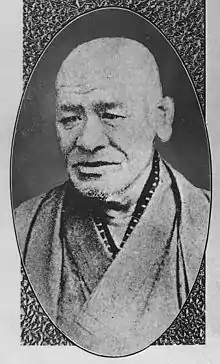Kurimoto Jōun
Kurimoto Jōun (栗本 鋤雲, 1822-1897) was a Japanese hatamoto samurai, physician, diplomat, philosopher, and journalist. He was also known to have used the name Sehē (瀬兵衛).
Kurimoto Jōun | |
|---|---|
| 栗本 鋤雲 | |
 Photograph of Kurimoto Jōun | |
| Personal details | |
| Born | May 1, 1822 Edo, Musashi Province, Japan |
| Died | April 6, 1897 (aged 74) Japan |
Biography
Jōun was born as the third son of Kitamura Kaien (喜多村 槐園), an official physician to the shogunate.[1] His elder brother, Kitamura Naohiro, was a prominent figure in the Shogunate's system of medical research institutes.
After preparatory study at the Kenzanrō (見山楼) academy run by the Cheng–Zhu scholar Asaka Gonsai, Jōun enrolled as a student at the Yushima Seidō. He soon graduated with excellent grades.
In 1848, Jōun succeeded into the Kurimoto family of physicians, and became a personal physician to the shogun. During that time, he also lectured on medicine.
In 1858, he was ordered to relocate to Ezo and settled in Hakodate, then a major outpost of the Matsumae clan. According to Shimazaki Tōson, the reason for this relegation was Jōun earning the ire of Oka Rekisen-In, chief of the Shogunate medical staff, by trying to recruit test passengers for the newly built Kankō Maru.[2]
In the following years, Jōun devoted himself to the development of Hakodate. His contributions included the construction of the Hakodate Medical Center (箱館医学所) with an eye to the eradication of the syphilis endemic to local brothels, management of the Nanaemura Medicinal Herb Garden (七重村薬園), the dredging of the Kunebetsu River to open it for shipping to Hakodate, and the promotion of cattle husbandry for milk and meat. Jōun was eventually promoted to head of the Hakodate bugyō, and conducted surveys of Japanese territory on Sakhalin and the Kuril Islands.
In 1863, Jōun was recalled to Edo. As the shogunate appreciated his achievements in Hakodate, he was promoted to the position of head of the Yushima Seidō's Shōheizaka Academy. Around that time Jōun also became a metsuke and was involved in the planning of the Shogunate naval yards. Due to his having developed expertise in military technology, he was rapidly appointed to the post of gaikoku bugyō and then finally kanjō bugyō, offices he held concurrently with his responsibilities as Hakodate bugyō. By 1866, he had formed a close friendship with Oguri Kozukenosuke.
Jōun became acquainted with Mermet de Cachon, the interpreter for Léon Roches, the French representative in Japan, during his time in Hakodate, and he had a good relationship with Roches as a result. Because of this, the shogunate asked Jōun to serve as a bridge between France and Japan. Jōun was thus involved in preparation for the first French military mission to Japan.
Jōun accompanied the delegation of Tokugawa Akitake which visited Paris for the 1867 World Exposition. During his stay in France, he worked on repairing Japanese-French relations, which had deteriorated due to the suspension of loans by France. He was also engaged in diplomatic negotiations with Britain and visited the Japanologist Léon de Rosny. There, he received news from foreign magistrate Kawakatsu Hiromichi of the return of temporal power to the young Emperor Meiji by Tokugawa Yoshinobu.
Jōun returned to Japan on June 24, 1868.[1] Jōun's reputation for genius impressed the revolutionary Imperial government, and he was invited to serve in a new capacity within its fledgling bureaucracy. However, Jōun refused the offer out of loyalty to the Shogunate, issued a formal apology, and went into seclusion.
At the suggestion of Kanagaki Robun, Jōun joined the Yokohama Mainichi Shinbun (横浜毎日新聞) newspaper in 1872 as a journalist. In the following year, 1873, he became the chief editor of the mail-order newspaper Yūbin Hōchi Shinbun (郵便報知新聞) and contributed by bringing on students of Fukuzawa Yukichi as reporters.
Around 1894, the twenty-two-year-old Shimazaki Tōson often visited the retired Jōun, who by that time had begun using the name Kon (鯤).[3]
He died of bronchitis in 1897 at the age of 76.[4]
Legacy
Jōun appears under the fictional name Kitamura Zuiken (喜多村 瑞見) in Shimazaki Tōson's 1929 epic novel Before the Dawn.
References
- 小野寺 Onodera, 龍太 Ryūta (2010). 栗本鋤雲―大節を堅持した亡国の遺臣 Kurimoto Jōun - taisetsu o kenji shita bōkoku no ishin. ミネルヴァ書房 Minerva Shobō. ISBN 9784623057658.
- 島崎 Shimazaki, 藤村 Tōson (December 28, 1954). 夜明け前 Yoakemae. Japan: 新潮社 Shinchōsha. ISBN 4101055084.
- 飯島 Ījima, 耕一Kōichi. 定型論争 Teikei ronsō. 風媒社 Fūbaisha. pp. 90–91. ISBN 4833120267.
- 服部 Hattori, 敏良 Toshirō (2010). 事典有名人の死亡診断 近代編 Jiten yūmeijin no shibō shindan kindaihen. 吉川弘文館 Yoshikawa Kōbunkan. p. 11.
Further reading
- De Lange, William (2023). A History of Japanese Journalism: State of Affairs and Affairs of State. Toyo Press. ISBN 978-94-92722-393.